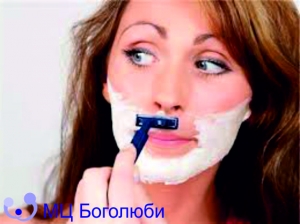Hirsutism is a condition characterized by abnormal hair growth in women in places typical for men - on the upper lip, chin, stomach, back, around the areola of the nipple.
Many experts do not distinguish between hirsutism and hypertrichosis, although these are terms with different meanings. Hirsutism indicates not so much an increase in hairiness, but rather the distribution and appearance of typically male hair, and hypertrichosis is excessive hair growth in areas where it is usually present.
Causes of Hirsutism
There may be several causes of hirsutism. In 95% of cases, the disease indicates problems with the ovaries, 3% - problems with the adrenal glands, about 1% - iatrogenic in nature (due to taking medications).
Sometimes hirsutism is not associated with obvious pathologies or predisposing factors, in these cases we are talking about idiopathic hirsutism. In recent years, a marked decrease in the incidence rate has been noted, in proportion to new scientific achievements in the field of endocrinology.
Menopause is characterized by a decrease in estrogen levels, which in turn causes an increase in the production of luteinizing hormone, and then androgen. Therefore, hirsutism can occur in the menopause. Less commonly, Cushing's syndrome (elevated levels of cortisol), hypothyroidism, and acromegaly accompany the disease.
The role of testosterone
The close relationship between androgens and problems such as seborrhea, acne and hirsutism itself is well known. The leading value in all these cases belongs to the testosterone mabolites (dihydrotestosterone and androstenediol glucuronide), which are formed in the hair bulb under the influence of the enzyme 5-alpha reductase. Although hirsutism is often characterized by physiological levels of testosterone, the concentration of the above enzyme can exceed the norm from five to twenty times. The disease is exacerbated by such predisposing factors as an increase in the number of androgen receptors and a drop in estrogen levels.
Diagnosis of hirsutism
Diagnosis is based primarily on the analysis of the medical history, examination of the skin, taking into account the number of hair follicles per centimeter of area and their pigmentation Of particular importance is the patient’s information regarding the rate at which hirsutism develops, the presence or absence of menstrual irregularities, and certain medications. Hirsutism in adolescents with changes in the monthly cycle and enlarged ovaries indicates polycystic ovary syndrome.
Launched hirsutism with partial masculinization of the external genital organs may suggest a non-tumor disorder of the adrenal cortex, while a disease that occurs suddenly makes you think about a tumor of the adrenal gland or ovary. When hirsutism persists for a long time, it is quite extensive, not associated with changes in the menstrual cycle, nor with acne, nor with seborrhea, then it is most likely an idiopathic hirsutism.
Sometimes the disease is associated with obesity and diabetes, in these cases, changes in carbohydrate metabolism with an increase in insulin levels are clearly visible.
It should also be noted that the moderate manifestation of hirsutism in pregnant women is a fairly frequent phenomenon. When diagnosing the disease, the doctor first determines the type of hirsutism, following a scale that assesses the presence of hair in 11 areas of the body, and assigns scores from 0 to 4 to each zone. To talk about hirsutism, the resulting sum of individual values should be more than eight.
Treatment of excessive hair growth in women
After a careful assessment of the patient's hormonal background, drugs that are active at different levels are prescribed. Some of them decrease testosterone and / or increase estrogen levels, others act as inhibitors of dihydrotestosterone (DTS), and inhibit the binding of dihydrotestosterone to intracellular receptors.
If hirsutism is accompanied by signs of verification, and drug treatment is ineffective or not recommended, then organ removal with hyperfunction may even be recommended. To solve the problem of hirsutism, you can make an appointment with the specialists of the Bogoliuby MC - a dermatologist and gynecologist-endocrinologist, as the treatment of the disease requires the help of several specialists.

















